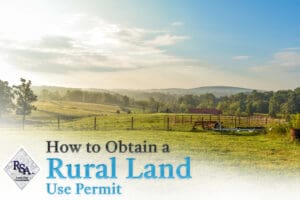 A rural land use permit is key to unlocking the potential of your rural property. Whether planning to build a home, start a farm, or develop a small business, you’ll need to obtain a rural land use permit before you begin. This permit ensures your project aligns with local zoning regulations and environmental standards. While the process can sometimes be complex, here’s what you need to know to navigate it smoothly.
A rural land use permit is key to unlocking the potential of your rural property. Whether planning to build a home, start a farm, or develop a small business, you’ll need to obtain a rural land use permit before you begin. This permit ensures your project aligns with local zoning regulations and environmental standards. While the process can sometimes be complex, here’s what you need to know to navigate it smoothly.
Steps to Obtaining a Rural Land Use Permit
1. Understand What a Rural Land Use Permit Entails
A rural land use permit is a document that grants you permission to use a specific piece of land for a particular purpose. This could be residential construction, farming, or commercial development. The permit process ensures your proposed land use aligns with the zoning laws and environmental requirements set by local and state governments. Because these requirements vary by region, it’s critical to check that your project falls within the permitted rural land uses.
2. Research Local Zoning Laws and Regulations
Rural areas are often categorized into agricultural, residential, commercial, or conservation zones. Your land’s zoning designation may restrict specific activities, limit building sizes, or impose preservation requirements, particularly if it’s near protected lands, water sources, or wildlife habitats. These zoning codes are often found on your county or municipal planning department’s website. If your intended use doesn’t match the current zoning, you may need to apply for a zoning change or variance, which can extend the permit process.
3. Consult with the Local Planning Department
Before submitting a rural land use permit application, set up a consultation with your local planning department. During this meeting, clearly outline your project, including its purpose, scope, and timeline. Local planning officials can provide insights into your project’s specific requirements and any potential obstacles. Some areas may require additional permits, such as environmental assessments or traffic impact analyses, so it’s helpful to understand the requirements upfront.
4. Gather Necessary Documentation
You’ll likely need supporting documents to apply for a rural land use permit. Typical required documentation includes:
- Property maps and site plans detailing your project’s location, boundaries, and proposed layout
- Environmental impact assessments if the project might affect local wildlife, water sources, or vegetation
- Project descriptions that provide details on your planned activities
- Supporting reports or studies, such as soil studies or traffic analyses
Ensure all documents are accurate and up-to-date, as incomplete applications can delay approval.
5. Complete and Submit the Permit Application
Once all the necessary documents are prepared, you can submit your application to the appropriate local agency or department, typically the planning or zoning department. Keep in mind any deadlines, processing fees, and submission guidelines. Sometimes, you may be required to submit additional information or undergo inspections as part of the application process.
6. Prepare for a Public Hearing
A public hearing may be required, especially if your intended land use is unconventional or could impact residents nearby. These hearings allow community members to ask questions and voice concerns about your proposed land use. Be prepared to present your project, address potential concerns, and highlight the benefits of your development to the local community. Consider bringing visual aids like site plans, impact studies, or projected benefits to communicate your vision better.
7. Address Environmental and Safety Concerns
Environmental and safety concerns are often a key focus of rural land use permits. If your project could affect local ecosystems, water quality, or public safety, take proactive steps to mitigate potential impacts. You might need to consult with an environmental engineer or ecologist to ensure your project meets local and state environmental standards.
8. Await Approval and Adhere to Conditions
Once the application and any hearing requirements are completed, the planning department will review your application. If approved, your rural land use permit will likely come with specific conditions, such as noise limits, hours of operation, or periodic inspections. Be diligent in meeting these conditions to avoid fines or having your permit revoked.
9. Consider Consulting a Land Use Specialist
For complex projects or first-time applicants, consulting with a land use planner or consultant, such as Richard Stevens & Associates, can be helpful. These specialists understand local regulations and can guide you through the permit process, ensuring your application meets all requirements. They can also assist in addressing environmental, logistical, or legal challenges that may arise.
10. Plan for Regular Compliance Checks
Compliance doesn’t stop after you’ve received your permit. Many permits require ongoing adherence to specific conditions, and some jurisdictions perform periodic checks to ensure land use remains compliant. Create a schedule to review your permit conditions and maintain any necessary inspections or updates to stay compliant.
Unlock Your Property’s Potential with Richard Stevens & Associates
Whether building a rural retreat, starting an agricultural venture, or setting up a small business, the rural land use permit process is key to bringing your vision to life. While the process can seem daunting, following these steps can make the journey smoother. Consulting with the experts at Richard Stevens & Associates can also simplify the application process. As your local land use planning experts, we have the experience and resources to ensure your rural project starts on solid ground. Contact us today to get started.
